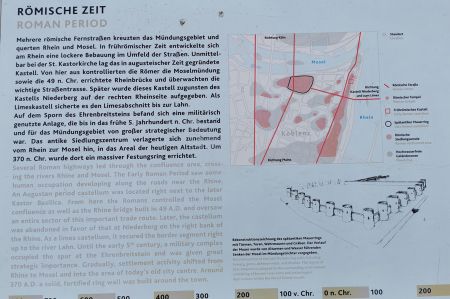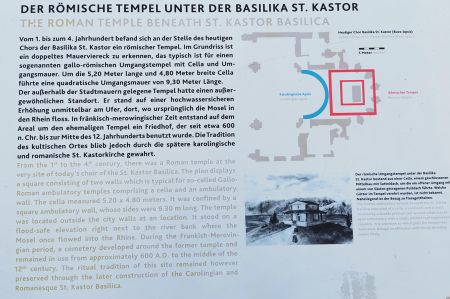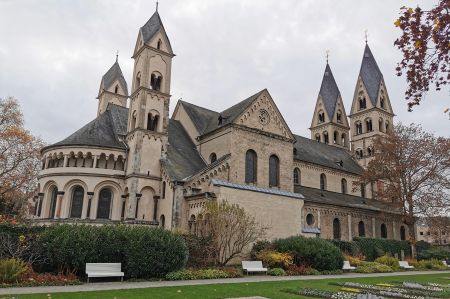Koblenz – The origin was the Castellum apud Confluentes
- Written by Portal Editor
The history of today's city of Koblenz was very changeable and is characterized by armed conflicts in numerous border conflicts and the associated major structural changes, also due to war damage.
Koblenz area has been inhabited since the Stone Age. The Romans first built a fortified urban settlement here in the area where the Moselle and Rhine meet. The Confluentes fort was built in what is now the old town centre to secure the Roman Rhine Valley Road (Mainz-Cologne-Xanten) and in Niederberg the Niederberg fort to secure the Limes and the first bridges over the Rhine and Moselle. Koblenz is one of the oldest cities in Germany. After the retreat of the Roman troops in the 5th century, Koblenz was conquered by the Franks, who founded a royal court here. In the Castor Church, consecrated in 836, which we will come to later, negotiations between the three grandsons of Charlemagne took place in 842, which finally led to the division of the Frankish Empire in the Treaty of Verdun in 843. Castellum apud Confluentes (German "castle at the confluence") was the Latin name for the Roman settlement at the confluence of Moselle (Mosella) and Rhine (Rhenus), from which the German city of Koblenz developed.
A first fort was built at the time of Emperor Augustus

Roman bridges were built over the Rhine and Moselle. A 350 meter long pier bridge over the Rhine was built around 49 AD between today's Ehrenbreitstein and the Koblenz side of the Rhine. It consisted of approx. 650-750 oak trunks with iron tips, so-called pile shoes, of which 51 have been preserved to this day. The Moselle Bridge, located 50 m from today's Balduin Bridge, was built as part of the Roman Rhine Valley Road.
Fort Niederberg on the right bank of the Rhine

Late Roman fort in the area of today's old town
In contrast to many other Roman fortifications, the Koblenz ring wall existed long after Roman times and was integrated into the medieval and modern cityscape. Its scheduled laying down did not take place until the 19th century.
City wall towers - Evidence has been provided
The towers were numbered from 1 to 19 by Adam Günther, starting on the northwest side. The foundations of the east tower of the old castle consist of the remains of a Roman round tower (tower 1). Extensive excavations on the Münzplatz were able to confirm the course of the Roman city wall on its westernmost side. However, there is no evidence of the intermediate towers 2 to 5 and the gate on the entire west side. Just the location of the south-west corner tower is documented again, as it is still entered in a cadastral map from 1812. The west side of the city fortifications is around 140 meters long.
Between corner tower 6 and the west gate tower of the south gate was another tower at a slight bend in the city wall, the stump of which served as a cesspool for sewage well into the 1870s. Just a few remains of the southern gate have been preserved and are accordingly well documented, but these are completely sufficient to reconstruct such a gate. Further eastwards, a section of the wall was found in various house foundations "Am Plan". Tower 8 was demolished in 1852 during the construction of the former house at Am Plan 7. Towers 9 to 12 and 16 to 19 have also been found. Tower 18 lies exactly under the apse of the Florinskirche and was uncovered during restoration work in 1929. The towers all except tower 1 had an outer diameter of around 10 metres. Wall thicknesses varied between 2 and 2.5 meters. The distances between the individual towers were between 24 and 35 meters, but most often 26 meters.
Koblenz conquered by the Franks and then founded a Frankish royal court
A temple complex for the Roman Mercurius and the Gallic/Celtic Rosmerta was built in what is now the city forest above Koblenz, not far from the Roman road. Roman coins found there show that the complex was used up until the 5th century. The remains of a Roman farm (Villa rustica) can be found on the Remsteck, which has been partially excavated and partially reconstructed.
The Rhine and Moselle bridges were probably destroyed when Roman troops withdrew in the 5th century. The Roman city wall survived until the early Middle Ages. To this day, remains of walls and streets in the old town of Koblenz bear witness to the late Roman fortifications.
Please read as well:
Dar Pomorza - three-masted sail training ship in Gdynia
